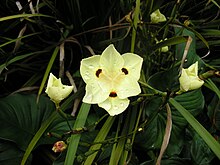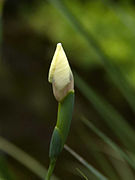
Dietes is a genus of rhizomatous plants of the family Iridaceae, first described as a genus in 1866. Common names include wood iris, fortnight lily, African iris, Japanese iris and butterfly iris, each of which may be used differently in different regions for one or more of the six species within the genus.

Iris sibirica, is a species in the genus Iris. It is a rhizomatous herbaceous perennial, from Europe and Central Asia. It has long green grass-like leaves, tall stem, 2–5 violet-blue, to blue, and occasionally white flowers. It is cultivated as an ornamental plant in temperate regions.

Dietes iridioides, commonly named African iris, fortnight lily, and morea iris, is a species of plant in the family Iridaceae that is native to Southern Africa.

Iris cristata is a species in the genus Iris, it is also in the subgenus of Limniris. It is a rhizomatous perennial plant, endemic to the eastern United States. It has pale lavender flowers with a white patch and orange or yellow crest. It is a close relative to Iris lacustris, the only other crested iris native to North America. It is cultivated as an ornamental plant in temperate regions.

Iris confusa (; also known as the bamboo iris is a species of iris, it is also in the subgenus Limniris and in the section Lophiris. It is a rhizomatous perennial plant, native to Western China. It has flowers which range from white to a soft lavender or pale blue in colour, with orange-yellow crests and purple dots. The plant's broad, shiny leaves are attached to bamboo-like stems. It is cultivated as an ornamental plant in temperate regions.
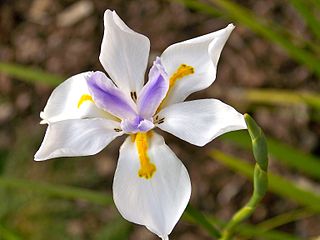
Dietes grandiflora, the large wild iris, African iris or fairy iris, is a rhizomatous perennial plant of the family Iridaceae with long, rigid, sword-like green leaves. This species is common in horticulture in its native South Africa, where it is often used in public gardens, beautification of commercial premises and along roadsides.

Iris japonica is a native of China and Japan. It is a species in the genus Iris, in the subgenus Limniris and within the Lophiris section. It is a rhizomatous perennial plant, with pale blue, lavender or white flowers with an orange or yellow crest. It is cultivated as an ornamental plant in temperate regions.
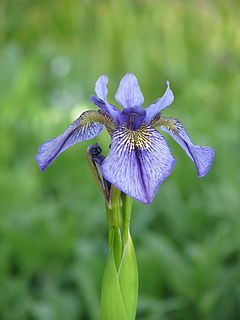
Iris delavayi is a species of flowering plant in the subgenus Limniris and in the series Sibiricae of the family Iridaceae. This rhizomatous herbaceous perennial comes from various provinces in China. It has grey-green leaves, long hollow stem, and 2 flowers in various blue shades. From dark violet, dark purple, purple-blue, dark blue to light purple. It is cultivated as an ornamental plant in temperate regions.
Iris tenuis is a plant species in the genus Iris, subgenus Limniris. It is a rhizomatous perennial, endemic to Clackamas County, Oregon. The flowers are white, pale blue or lilac, with a yellow or golden low dissected crest and pale green leaves. It is cultivated as an ornamental plant in temperate regions.

Iris variegata is a plant species in the genus Iris, also in the subgenus Iris. It is a rhizomatous perennial from eastern Europe. It has dark green, ribbed leaves. The branched flowering stems can be as tall as the leaves, they can hold 2–3 flowers in summer. They are yellowish-white, with brown-purple veins on the drooping falls. It is very hardy and it is commonly cultivated as an ornamental plant in temperate regions. There are several cultivars.
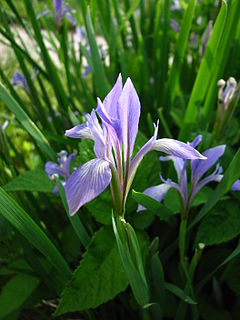
Iris lactea is a species in the genus Iris, it is also in the subgenus Limniris. and the series Ensatae, it is the only species in the series. The Japanese water iris, Iris ensata, is actually in series Laevigatae. It is a rhizomatous perennial, from central Asia, with pale blue or violet flowers. It is cultivated as an ornamental plant in temperate regions.
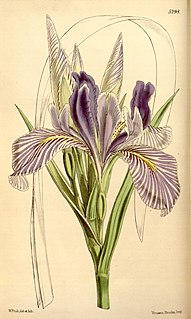
Iris longipetala is a species in the genus Iris, it is also in the subgenus Limniris and in the series Longipetalae. It is a rhizomatous perennial, from North America. It has dark green or bluish green, grass-like leaves, small stem and 3–8 flowers, that range from creamy-white, pale blue to lavender blue. It is cultivated as an ornamental plant in temperate regions.

Iris wilsonii is a species of flowering plant in the family Iridaceae, native to China. It is placed in the series Sibiricae of the subgenus Limniris of the genus Iris. This rhizomatous herbaceous perennial has long and drooping grey-green leaves, hollow stems and two fragrant yellow, pale yellow or yellow/white flowers.
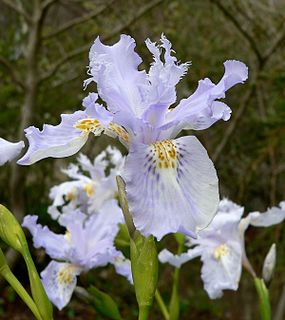
Iris wattii is a plant species in the genus Iris, it is also in the subgenus Limniris and the section Lophiris. It is a rhizomatous perennial plant. It is native to China, Burma and India, it has lavender or light blue flowers. It is also known as 'Bamboo Iris'. It is cultivated as an ornamental plant in temperate regions.

Iris arenaria is a species in the genus Iris; it is also in the subgenus of Iris and in the Psammiris section. It is a rhizomatous perennial, from Central Europe, found in Hungary, Austria, Romania, Czech Republic and Ukraine. It has grass-like leaves, a short stem and pale yellow flowers. It has had a mixed origin and was once Iris humilis subsp. arenaria, a subspecies of Iris humilis, until it was reclassified as a separate species. But many sources still state that it is either a synonym or subspecies of Iris humilis. It is cultivated as an ornamental plant in temperate regions.
Iris cuniculiformis is a plant species in the genus Iris, it is also in the subgenus Iris and in the section Pseudoregelia. It is a rhizomatous perennial, from China, it has long and thin green leaves, and 1 lilac large flowers, that have yellow or grey beards. It is cultivated as an ornamental plant in temperate regions.
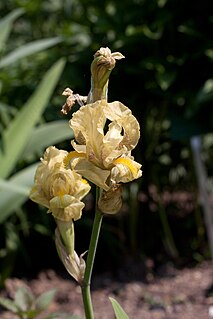
Iris imbricata is a species in the genus Iris, it is also in the subgenus Iris. It is a rhizomatous perennial, from the Caucasus mountains, within Iran, Armenia, Azerbaijan and Georgia. It has broad, sword-like, yellow green or light green leaves, slender stem with branches, inflated and overlapping green spathes, and 2–5 yellow, pale yellow or greenish yellow flowers.
Iris purpureobractea is a plant species in the genus Iris, it is also in the subgenus Iris. It is a rhizomatous perennial, from the cliffs and forest glades on the mountains of Turkey. It has straight or falcate shaped leaves, stem with several branches, the stem has purple spathes, it has up to 8 fragrant flowers, in various colours between yellow or blue. It is cultivated as an ornamental plant in temperate regions.

Iris subbiflora is a plant species in the genus Iris, it is also in the subgenus Iris. It is a rhizomatous perennial, from Portugal and Spain in Europe. It has evergreen broad leaves, forming dense clumps, it has dwarf stems in late spring,, with 1 upright fragrant flower, in shades of purple, light red purple, grey-blue, blue-violet, or dark violet. It has a beard which is generally blue, purple, or violet, but can fade to white, dull yellow, or dark yellow. After being found in 1804, it was once a separate species until the late 70s, when it was reclassified as subspecies of Iris lutescens, and renamed Iris lutescens subsp. subbiflora. But in the 80s it was returned to an independent species but some authors and references still class the species as a synonym or subspecies. It is cultivated as an ornamental plant in temperate regions.
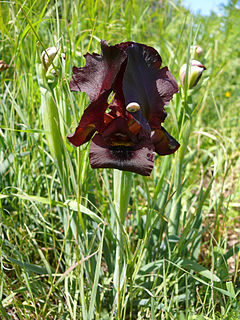
Iris atropurpurea, the coastal iris, is a species in the genus Iris, it is also in the subgenus of Iris and in the section Oncocyclus. It is a rhizomatous perennial, from Israel. It has glaucous (blue-green), linear, falcate (sickle-shaped) leaves. Between February and March, it has between 1 and 2 flowers, in dark shades from red-brown, burgundy, dark purple to blackish purple. They have a darker signal patch and yellow beard tipped with purple. It is rarely cultivated as an ornamental plant in temperate regions, due to it needing very dry conditions.
